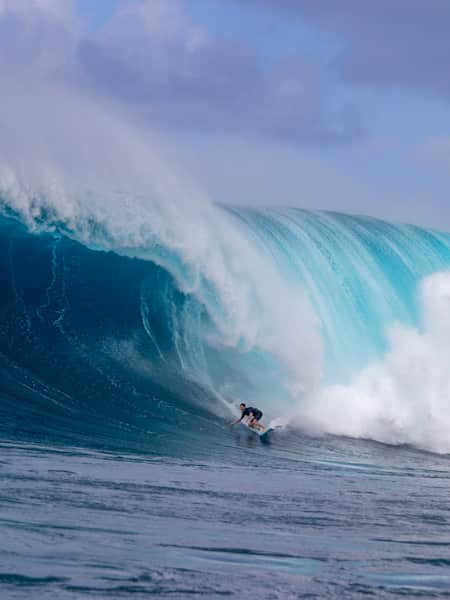Surfing
There’s an art to knowing the exact right moment to catch a good wave, and it’s not something you can achieve overnight. For Red Bull surfer Ian Walsh, the ability to surf record-setting swells has taken years of experience in the water.
“It's the pinnacle of what I can do in the ocean,” he says. "I'm using everything I've learned from a lifetime of being in the ocean and I'm boiling it down to those few seconds before you get into a big wave."
Learning the delicate timing of seizing a great wave starts with understanding what conditions make for the best surfing. That, of course, has a lot to do with whether you’re surfing at high or low tide. It’s not so much about which is better than the other but which is best in your particular environment. If you’re trying to find the best time to surf, high tide or low tide, read ahead for the pros and cons of each.
01
High tide surfing
The ocean’s tide patterns occur as the earth experiences the push-pull gravitational effect of the sun and moon. As you might have guessed, high tide occurs when the water is at peak height, which happens twice a day on most coasts. Since the water is deeper at high tide, you usually find bigger, more powerful waves. Regardless of which end of the tide cycle you’re surfing, the currents during incoming tides are generally better than outgoing tides for beginners. Surfing an hour before maximum high tide is usually ideal if you want waves with great height and speed.
Advantages of high tide surfing
It depends on the spot, but surfing at high tide can have some huge perks, especially if you’re a beginner. Here are some of the benefits of surfing at high tide.
- Extra time to paddle out. Beginners need plenty of time to pick up speed and get on their board. The extra depth at high tide can make that a lot easier.
- More waves. As you get closer to high tide time, waves start to increase in intensity and frequency, so you have more opportunities to catch one. The waves that form at high tide are usually great for beginners.
- Perfect for reef breaks. If you’re surfing where the waves break far out on a coral formation, you need enough water to cover the reef. High tide may be the only safe time to surf at these reef breaks.
Challenges of high tide surfing
High tide surfing isn’t the best choice for all surf spots. Here are some of the instances where high tide waves aren’t the better option.
- Larger crowds. If you’re at a spot with a popular high tide, that could mean more surfers — and more competition for the best waves. It’s always a good idea to follow basic surf etiquette, such as giving the right of way to the surfer closest to an incoming wave. This is especially important if you’re at a packed beach during high tide.
- Potential hazards. Some steeper beaches have a shore break, a type of beach break where the waves form far out but break on the shore. These can be risky at high tide — if you’re not careful, you could crash your board right into the sand. Shore breaks aren’t impossible to surf but should generally be reserved for more advanced surfers.
- Backwash formations. Shore breaks at high tide can also cause smaller waves to form and interfere with larger waves. This phenomenon is known as a backwash wave, and it can pose major challenges if you’re looking to catch good waves.
02
Low tide surfing
The other end of the tidal range occurs when the water is at its lowest point, covering the least amount of shoreline. With the water receding as far from the beach as possible, this is when you’re most likely to see exposed reefs or sandbars. Since low tide means less water, the waves at this point in the tide cycle tend to form a hollow shape. If you’re following the suggestion of aiming for an incoming tide, an hour just after low tide is best.
Advantages of low tide surfing
If low tide is the only part of the day when you have time to surf, this can sometimes be a blessing. These are some of the pros of surfing at low tide.
- Less competition. Those who choose to surf at high tide may have to wade through crowds during those primetime waves. At low tide, though, you’ll usually have plenty of room to yourself. If you’re just starting out, not having to deal with throngs of experienced surfers can feel relieving.
- Better for certain surf breaks. Surfing where there’s a beach break is less difficult when the tide is lower. You also won’t have to paddle out too far for rideable waves with a traditional beach break. This is great if you’re a new surfer and need to save your strength. Plus, if you encounter a shore break, you’re less likely to collide with the sand at low tide.
- Great waves for barreling. The waves produced at low tide are perfect for barreling or tubing — riding the face of a hollowed-out wave. This is more of an advanced move, but it can be lots of fun once you build confidence on your board.
Challenges of low tide surfing
Of course, a lower tide can affect surfing in some unfavorable ways too. Here are some of the reasons a low tide for surfing isn’t always a good idea.
- Exposed hazards. You’ll see more rocks exposed during low tide, which means more obstacles that could be potentially dangerous.
- Weaker, unstable waves. As the tide drops, waves lose height and power. These leaner waves can also occur alongside choppy, unpredictable currents as the tide turns, so it’s important to watch out for riptides.
- Dumping waves. Hollow waves can be a blast to surf, but they also run the risk of closing out too soon. This is known as “dumping” or “plunging.” These can knock you down, similar to what can happen with a shore break at high tide.
Learn the best time to surf for you
The art of finding the right wave varies from place to place and day to day. High-tide waves might be better for beginners, but it all depends on the beach where you’re surfing. Always check conditions before you get in the water, which you can usually see through your local National Oceanic and Atmospheric Administration (NOAA) buoy report. Surf shops near where you’re surfing often run their own forecasts and shoreline cameras as well. Once you’ve found the right tide time, you’re all set to catch the perfect wave.
Fan of surfing? Dive into the latest season of 'The Life Of Kai' for free on Red Bull TV.

26 min
Rescue
Kai Lenny kicks off the big wave season at Jaws and faces the risks that come with his pursuit of progression.











